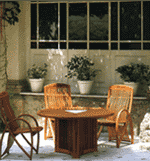Craft Gallery
This section features the main elements of Indonesian crafts not
covered in the previous categories. This is by no means exhaustive,
and will be updated on a regular basis.
Masks and Puppets
Masks and puppets date back to the first ritual dances in pre-historic
Indonesian culture, and are still widely used today for fertility
rites, planting ceremonies, ancestor worship and other auspicious
occasions. Masked dance performances abound in Bali where the forces
of good and evil play out their eternal battles; the most famous
character of these is the fearsome dragon-lion beast, the Barong.
Balinese and Javanese masks are usually elaborately decorated, whereas
the more primitive ethnic designs of East Nusa Tenggera are typically
chunky, dark woodcarvings with shell and bone inlays.
The best known puppets are those from Java. Epic tales from the
Ramayana and Mahabarata are played out either with wayang golek
(wood and cloth dolls) on a miniature stage, or with wayang kulit
(flat leather puppets) in the famous shadow plays. The puppet master
- dalang - skillfully maneuvers the puppets behind a brightly-lit
screen, and the audience only sees the shadows. Wayang golek and
wayang kulit puppets are elaborately decorated to depict the specific
characters of the epic tales, but it is the talent of the dalang
that brings them to life and gives voice to the puppets.
Pottery
Prehistoric earthenware pots dating back to more than 3,000 BC have
been found in Sumba and South Sulawesi. What is striking about these
discoveries is not the age, however, but the fact that the process
of making pottery has hardly changed in 5,000 years. Local clay
is shaped by hand, then fired in open bonfires, usually made from
waste farm produce. As a result, pottery has developed hand in hand
with farming, and pottery villages can be found in every province.
Tools are very basic, yet decorations can be enormously elaborate.
Pottery making as an artform reached its apogee in the 14th century
Majapahit Empire, where intricately decorated ceremonial objets
adorned the palaces in addition to the usual array of household
utensils.
Woodcraft
The rainforests prevalent throughout Indonesia have supplied abundant
wood for tool making and decorative work. The most ancient forms
of woodcraft were weapons and ancestral wooden posts - totems dedicated
to honouring the spirits of ancestors. These are still found in
the tribal societies of Irian Jaya, Sulawesi and Kalimantan today.
Highly decorative wooden picture frames, boxes, containers and a
myriad of other household objects are also present in the rural
households of Indonesia, but it is the Balinese who have raised
woodcraft to a level of internationally acclaimed artistry. In Bali,
there is often no real distinction between art and everyday life,
the two being inextricably intertwined. Woodcarving families have
long traditions creating objects of exquisitely intricate beauty
dedicated to their Hindu gods, and this tradition has flourished
into a major industry today. Children learn the feel of wood and
chisel from an early age, and it was the extraordinary talents of
woodcarvers that led to Michael Covarrubias' claim that "every Balinese
is an artist".
Basketry
Baskets and other woven objects abound in virtually every village
in Indonesia, although specific designs and materials distinguish
the basketry of one area from another. Wafer-thin bamboo, rattan,
orchid fibres, reeds and rushes, grasses and coconut palm leaves
are all used to produce everyday items and ceremonial objects. Often
the only tool required is a pair of skilled hands. Walls, mats,
shields, baskets, boxes, hats, carrying equipment, decorative ornaments
and religious offerings, even musical instruments and water containers
are all produced by simple yet high versatile plaiting and weaving
methods. More complex and specialised techniques are employed to
produce objects of ceremonial importance, the town of Tasikmalaya,
in West Java, being one of the best-known producers fine quality
basketry.









